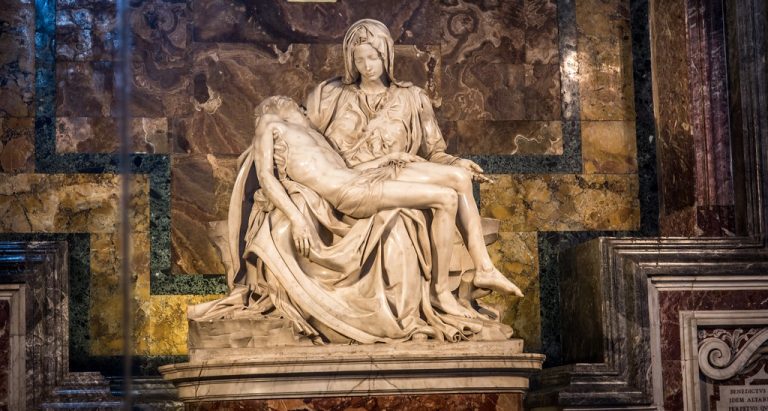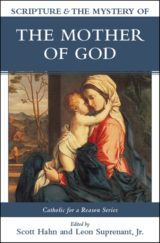By Scott Hahn
Scott Hahn, founder and president of the St. Paul Center, is a world-renowned scholar, speaker, and author. He is the best-selling author of over forty books on the Catholic faith.

The history of redemption is a story that involves human participation. The Apostle Paul spoke of this mystery when he stated, “We are God’s co-workers” (1 Cor 3:9). How is this? Can’t God get the job done Himself? Of course He can. But since He is a Father, His job is to raise up mature sons and daughters by making us co-workers. And His work is our redemption, which He shared in an unparalleled way with Mary—to whom God entrusted such tasks as feeding His Son with her own milk, singing Him to sleep, and accompanying Him all the way to the Cross where she gave her sorrowful yes to His self-offering. In short, the Father willed that His Son’s entire existence as a man would hinge, so to speak, upon the ongoing fiat of Mary. Can there be a more intimate “co-worker”?
Being a disciple, a co-worker with Jesus, takes effort. At times, it takes suffering. One passage that seemed to have escaped my attention as a Protestant was Saint Paul’s rather curious line, “I rejoice in my sufferings for your sake, and in my flesh I complete what is lacking in Christ’s afflictions for the sake of his body, that is, the church” (Col 1:24). Cradle Catholics may remember with some fondness being told (in the event of an unsuccessful team tryout, a skinned knee, or a broken heart) to “offer it up.” This simple phrase holds the key that unlocks the mystery of our co-redemption. By consciously uniting our sufferings to Our Lord’s redemptive sufferings, we become co-workers. By uniting her heart to His, especially at Calvary, the Blessed Mother became the co-worker par excellence.
This understanding was summarized at Vatican II (1962-65):
This motherhood of Mary in the order of grace continues uninterruptedly from the consent which she loyally gave at the Annunciation and which she sustained without wavering beneath the cross, until the eternal fulfillment of all the elect. (Lumen Gentium 62; cf. CCC 969)
However, Mary’s divine maternity did not end with her Son’s Resurrection and Ascension, nor even after her Assumption, as Lumen Gentium continues:
Taken up to heaven she did not lay aside this saving office but by her manifold intercession continues to bring us the gifts of eternal salvation. . . . Therefore the Blessed Virgin is invoked in the Church under the titles of Advocate, Helper, Benefactress, and Mediatrix.
It is significant that Vatican II and the Catechism describe Mary’s divine motherhood as a “saving office,” which provides the basis for her rather remarkable titles. But what is meant by the phrase “saving office”?
A well-trained theologian, Pope John Paul II has introduced the compact phrase “maternal mediation” into the Church’s theological vocabulary. And it seems to capture the very heart of Marian doctrine and devotion.
As an Evangelical, I used to rush to the one verse that seemed to snuff out this seemingly heretical spark: Saint Paul’s categorical assertion that Christ is the only “mediator between God and men” (1 Tim 2:5). How dare we refer to Mary’s maternal mediation!
First, the Greek word used here for “one” is eis, which means “first” or “primary,” not monos, which means “only” or “sole.” Just as there is one mediator, there is also one divine sonship, which we all share—by way of participation—with Christ (filii in Filio, sons in the Son). Christ’s mediation does not exclude Mary’s, but rather establishes it, by way of her participation.
Furthermore, the Epistle to the Hebrews explains Christ’s high priesthood in terms of His being the first-born Son of God (Heb 1:5–2:17), which serves as the basis for our divine sonship (Heb 2:10-17), as well as our priestly sanctity and service (Heb 13:10-16; 1 Pet 2:5). Once again, there is no tug-ofwar between Christ’s one priesthood and our participation in it.
As first-born Son in God’s family, Jesus mediates as the High Priest between the Father and His children, whereas Mary mediates as Queen Mother (1 Kings 2:19; Rev 12:1-17). This is what her maternal mediation is all about. For the Father, Mary mothers the Son. For us sinners, she mothers our Savior. And for her Son, she mothers His siblings. When it comes to Mary’s role in God’s saving plan, “mother” is not only a noun, but a verb, and hence an office.
As the Mother of God and His children, Mary shows us how to glorify the Father, not by groveling, but by receiving the gift of His Son in the fullness of the Spirit. That is how God’s sovereign grace enables us to share in His glory, and so become “partakers of the divine nature” (2 Pet 1:4). So if you want to judge how well a person grasps the Gospel in its essence, find out how much they make of having God as their Father—and Mary as their mother.
You Might Also Like
 Mary. Who is this hidden and humble woman? Her yes to God’s plan changed the world forever. Yet for many, this quiet Mother remains a controversial and ambiguous figure. Catholic for a Reason II: Scripture and the Mystery of the Mother of God explores the mystery of Mary, the Mother of God, through the personal study and reflection from well known Catholic authors including Scott and Kimberly Hahn, Curtis Martin, Tim Gray, and more.
Mary. Who is this hidden and humble woman? Her yes to God’s plan changed the world forever. Yet for many, this quiet Mother remains a controversial and ambiguous figure. Catholic for a Reason II: Scripture and the Mystery of the Mother of God explores the mystery of Mary, the Mother of God, through the personal study and reflection from well known Catholic authors including Scott and Kimberly Hahn, Curtis Martin, Tim Gray, and more.

